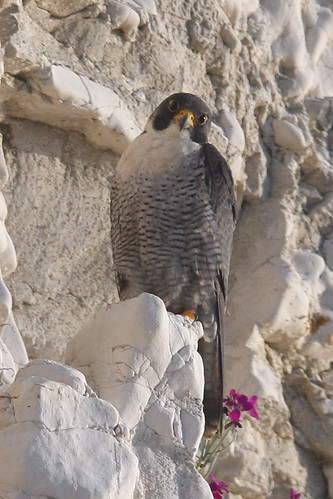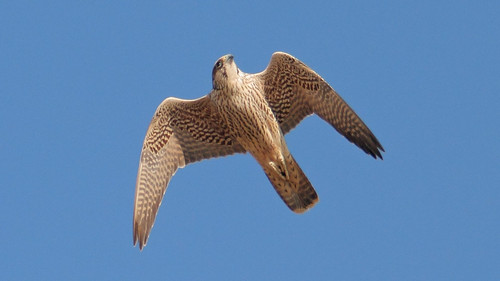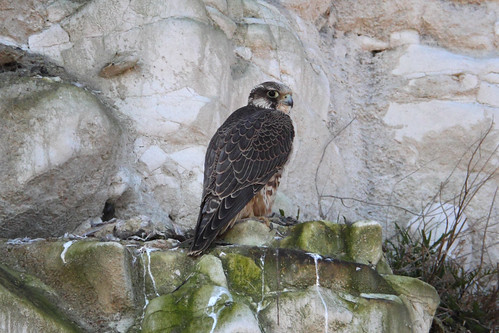The peregrine makes its presence felt long before you see it: a dead pigeon lies on its back on a windswept beach, its wings spread and its breastbone stripped of meat; a golfer notices your camera and calls out to tell you that you "just missed a peregrine"; fulmars cackle their disapproval as a crossbow-shaped shadow glides over their nests and across the cliff-face. You walk and you walk until finally you see a hunched, powerful-looking bird poised on an outcrop of flint. On the beach below a man is walking his dog, blissfully unaware of the apex predator right above his head, but when you peer through the lens you see that the peregrine is looking at you, not the dog or its owner. A peregrine sees everything and misses nothing. It spotted you the moment you stepped into its field of view, and now that it knows you're looking at it, the peregrine alone will decide how close you will be allowed to get.
Thanks to works like J.A. Baker's The Peregrine, the eponymous falcon enjoys a near-mythical status unmatched perhaps by any other British bird. Baker's account (I can't really call it a memoir since the author effectively excises himself from the narrative) condenses a decade's worth of observations into a single year, a structural choice which also has the effect of condensing his patient study of the peregrine into a singularly obsessive quest. Reading it, you're left in little doubt that Baker - short-sighted and afflicted with a rare and rather unpleasant form of arthritis (I speak from experience on the latter) - wishes he were a peregrine himself:
Free! You cannot know what freedom means till you have seen a peregrine loosed into the warm spring sky to roam at will through all the far provinces of light. Along the escarpments of the river air he rose with martial motion. Like a dolphin in green seas, like an otter in the startled water, he poured through deep lagoons of sky up to the high white reefs of cirrus.
Like dark chocolate, Baker's dense, synaesthetic prose is probably best savoured in small chunks. And yet, for all the linguistic fireworks on display, the narrative is tinged with a wistful, elegiac tone. Baker had good reason to be pessimistic; at the time he wrote his book the peregrine was in serious decline - its numbers ravaged by persecution and pesticides.
But for once, the story has a happy postscript (albeit one that Baker himself didn't live to see). Peregrine Falcons have enjoyed a spectacular resurgence and you can now see them right across the country, repopulating urban environments as well as their more traditional hunting grounds. If you live near a cathedral or a high chalk cliff, there's a good chance you also live near a peregrine. And when you see one for yourself you'll understand why these majestic birds inspire such reverential prose.
See also:
More of my Peregrine photos on Flickr
Keith Ross's YouTube channel (includes a series of short films on the Ramsgate Peregrines)
Peregrine Falcon (RSPB)
Peregrine Falcon (Birdforum)
Peregrine Falcon (Birdguides)



